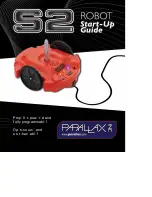
3
This iBOTZ kit is an ideal introduction for someone wanting to investigate the fascinating
world of robots and intelligent machines.
The kit introduces the fundamentals of sensor technology and shows how sensors, electronic
circuit boards, and motors can be combined with carefully designed mechanical gears and
shafts to produce a robot that walks and avoids obstacles.
Clap you hand and watch TRIBOTZ move away. Draw a black line on a white sheet of paper
and watch it follow along. Put some obstacles in front of TRIBOTZ and see it steer around
them. How does it do all that?
By reading this manual you will find out what the components in your iBOTZ HYDRAZOID
do, and how they work together to generate its behavior. In the process you will be introduced
to some basic electronics and aspects of engineering design.
We have iBOTZ robots in our laboratory at the Open University, and they are always a big hit
with visitors. When you have built and experimented with yours, you will be ready to move
on towards the more advanced robots that are used for research. Have fun!
Professor Jeffrey Johnson
Department of Design & Innovation
The Open University
http://technology.open.ac.uk
4
History of Robots
Definition of a Robot
According to The Robot Institute of America (1979) :
"A reprogrammable, multifunctional manipulator designed to move materials, parts, tools, or
specialized devices through various programmed motions for the performance of a variety of
tasks." According to the Webster dictionary: "An automatic device that performs functions
normally ascribed to humans or a machine in the form of a human (Webster, 1993)."
A brief review of robot development is important as it puts the current machines and interest
in them into an historical perspective. The following list highlights the growth of automated
machines that led to the development of the industrial robots currently available today.
250BC
One of the first robots was the clepsydra or water clock, which was made in 250 B.C. It was
created by Ctesibius of Alexandria, a Greek physicist and inventor.
1801
Joseph Jacquard invents a textile machine that is operated by punch cards. The machine is
called a programmable loom and goes into mass production.
1830
American Christopher Spencer designs a cam -operated lathe.
1892
In the United States, Seward Babbitt designs a motorised crane with gripper to remove ingots
from a furnace.
1921
The first reference to the word robot appears in a play opening in London. The play, written by
Czechoslovakian Karel Capek, introduces the word robot from the Czech robota, which means
a serf or one in subservient labour. From this beginning the concept of a robot takes hold.
1938
Americans Willard Pollard and Harold Roselund design a programmable paint-spraying
mechanism for the DeVilbiss Company.
1948



































